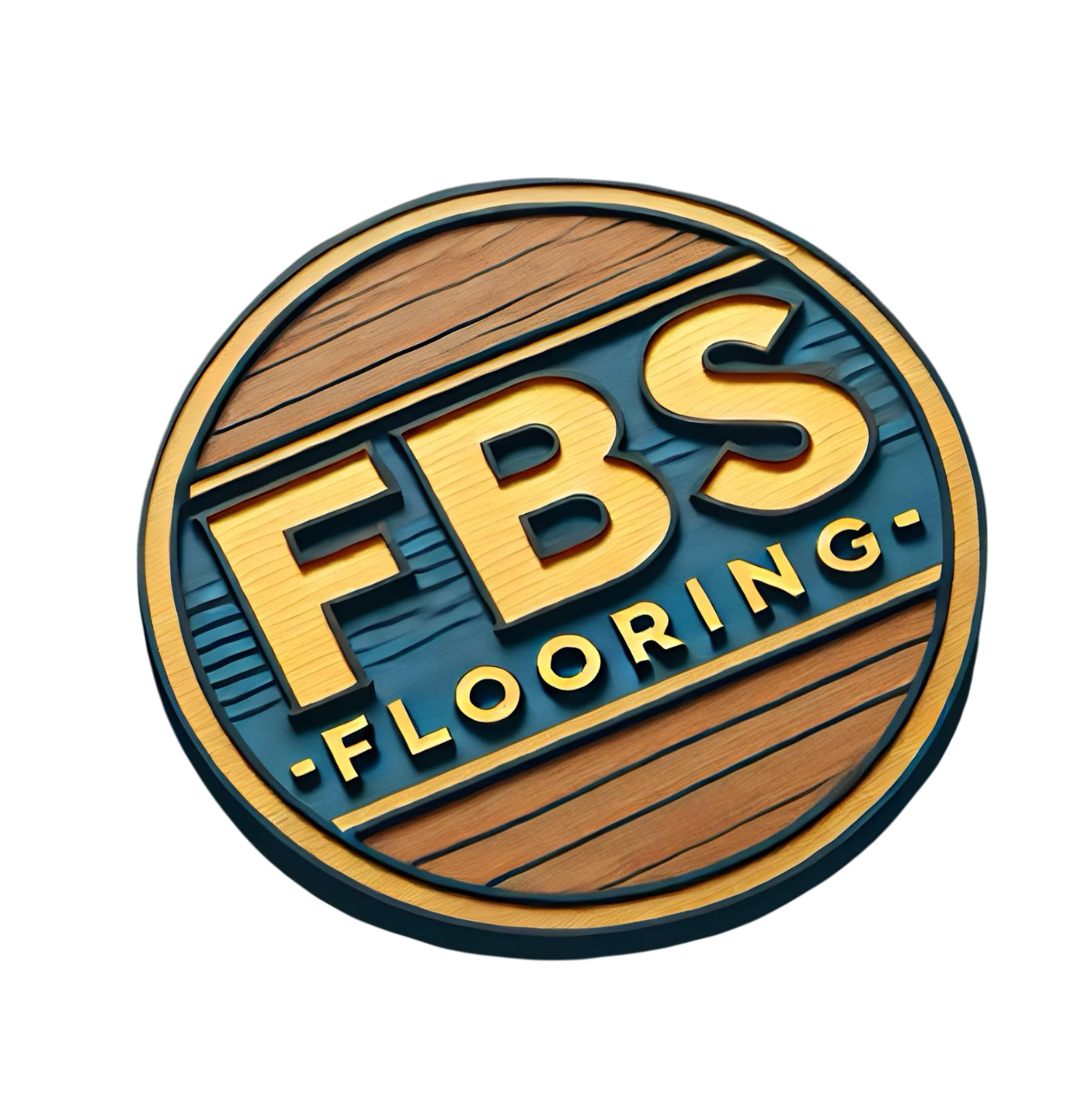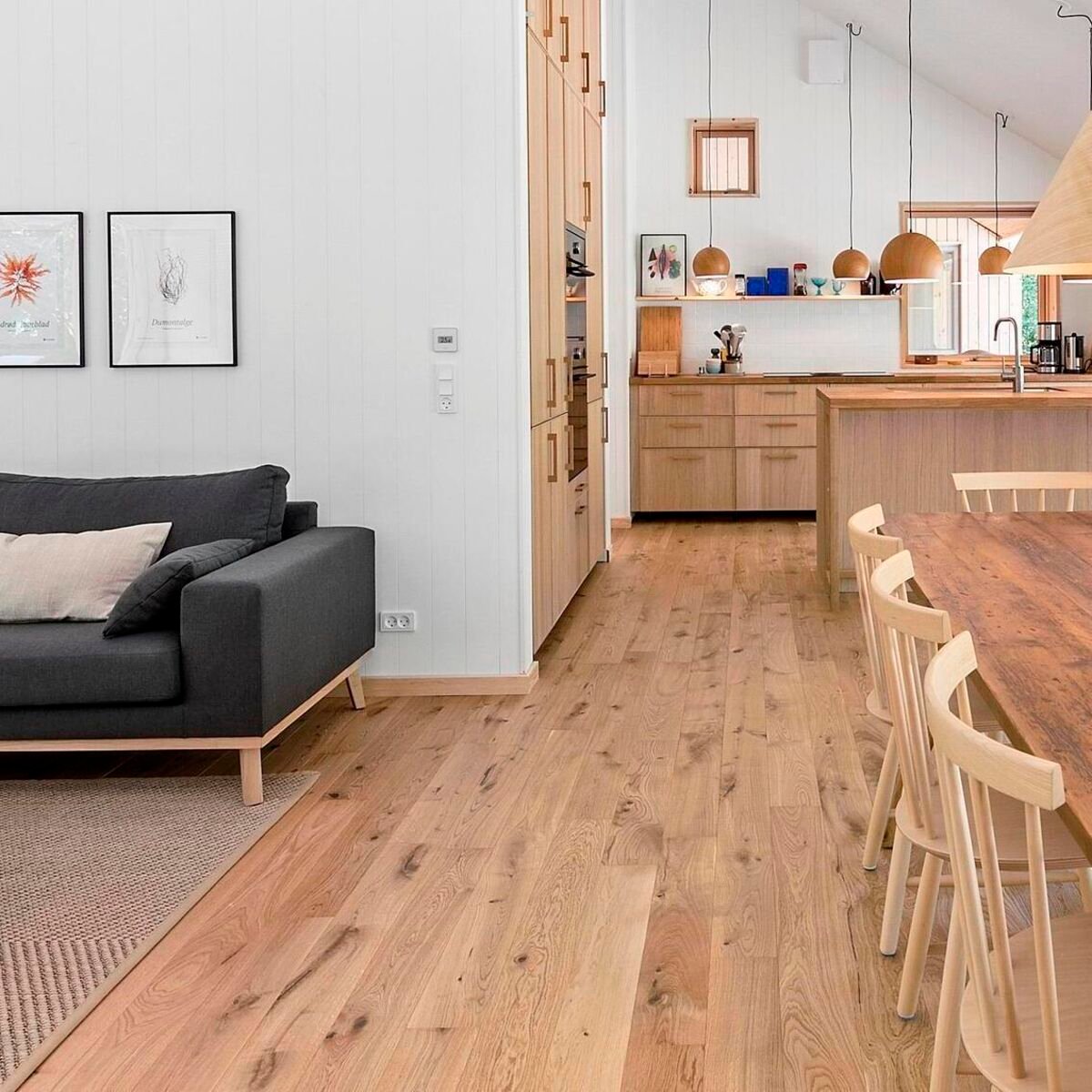Section 1: Introduction to Floor Fitting in Dublin
When it comes to upgrading a home or business space, few improvements make a bigger impact than a well-fitted floor. In Dublin, where traditional Georgian townhouses sit side by side with modern apartments and newly built homes, choosing the right flooring and ensuring it is fitted correctly is both a style and a practical decision. Good flooring not only elevates the appearance of a room but also improves comfort, safety, and long-term property value.
For Dubliners, flooring brings unique challenges. The city’s damp climate and older housing stock mean that subfloors often require careful preparation before new materials are laid. Many older homes still have timber joists, which can creak, warp, or suffer from unevenness. Meanwhile, new-build apartments in areas like Docklands or Sandyford often come with concrete bases that need levelling and moisture-proofing before floor installation. Understanding these local conditions is crucial to achieving a flawless finish that lasts.
Floor fitting is much more than simply placing boards, tiles, or carpet onto a surface. It is a detailed process that includes assessing the subfloor, installing underlay, using correct fitting methods, and adding finishing touches such as skirting boards or trims. Without professional expertise, homeowners risk problems such as gaps, squeaks, or premature wear. For this reason, most Dublin residents turn to professional floor fitters who bring not just tools and skills, but also the local knowledge needed to handle challenges specific to Irish homes.
This guide has been designed as the definitive resource on floor fitting in Dublin. Whether you are renovating a period house in Rathmines, refreshing a family home in Clontarf, or furnishing an investment apartment in Tallaght, the sections that follow will cover everything you need to know. From flooring types and costs to choosing the right fitter, from step-by-step installation to long-term care, every detail is explained with practical insights and local expertise.
By the end of this article, you will have a clear understanding of flooring options available in Dublin, what to expect during installation, and how to ensure your investment stands the test of time. Most importantly, you will gain the knowledge to make informed decisions and avoid costly mistakes.
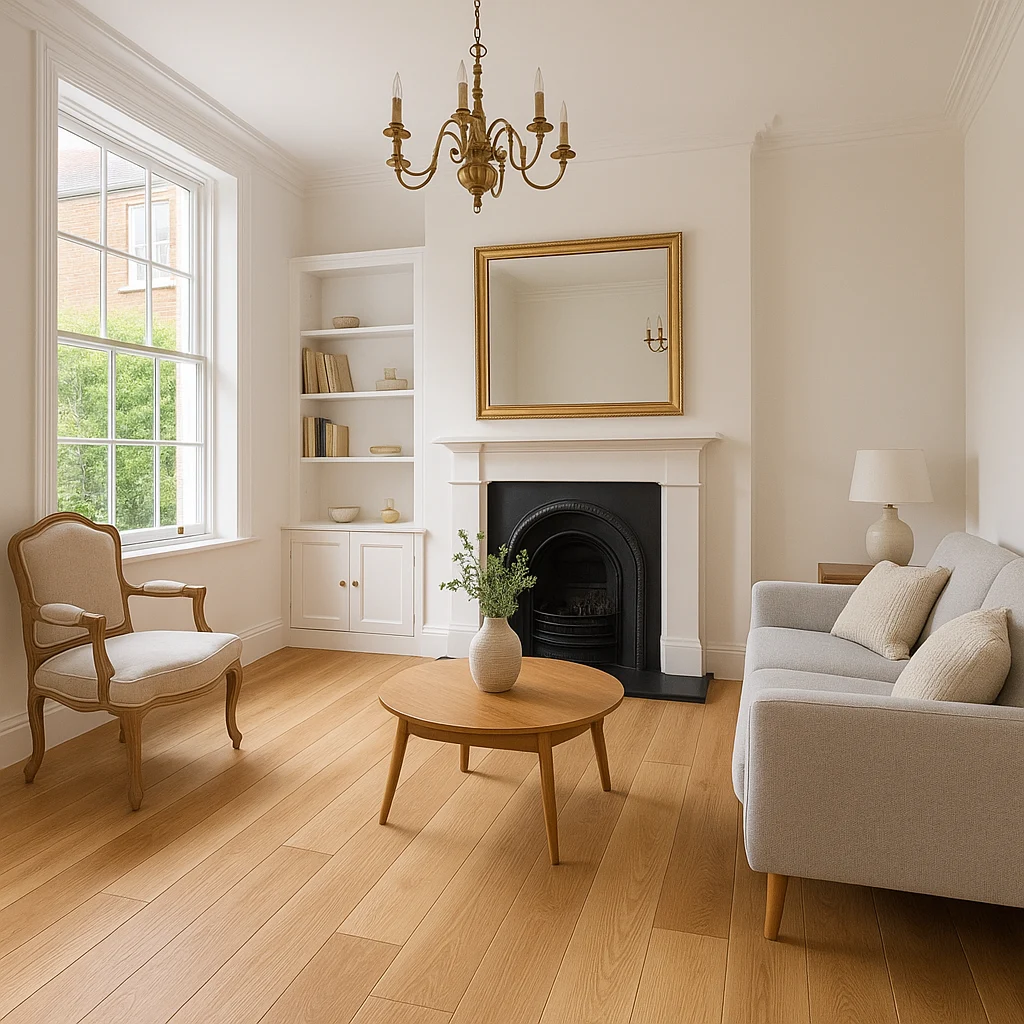
Section 2: Understanding Floor Fitting
Floor fitting is often mistaken for a straightforward task, placing planks, tiles, or carpet directly on a surface. In reality, it is a multi-step process that requires careful planning, technical knowledge, and the right tools. In Dublin, where housing types vary from Victorian terraces to modern office blocks, understanding the fundamentals of floor fitting is the first step to achieving durable, long-lasting results.
What Is Floor Fitting?
At its core, floor fitting means preparing a surface and installing flooring material so that it looks beautiful, functions well, and lasts for years. It is not limited to laying a floor covering. A professional fitting job includes:
- Assessing the subfloor – checking for dampness, cracks, or unevenness.
- Preparing the base – levelling, sealing, or repairing the surface.
- Installing underlay – for insulation, soundproofing, and moisture resistance.
- Laying the flooring – using the correct method for the material chosen.
- Finishing touches – adding trims, thresholds, and sealants.
When done correctly, the result is a seamless floor that enhances both the look and function of the space.
The Role of Subfloor Preparation
In Dublin homes, subfloor preparation is one of the most critical steps. Many older Georgian and Edwardian houses have timber subfloors, which may suffer from dampness or uneven joists. If not addressed, these issues can cause creaks or even structural damage to the new floor. Apartments with concrete subfloors may need levelling compounds to eliminate dips and cracks. Ignoring this step often leads to problems such as lifting, warping, or gaps appearing within months.
Fitting Methods Explained
Different flooring materials require different fitting methods:
- Floating floors (laminate or engineered wood) “float” above the subfloor, connected by click-lock systems.
- Glue-down floors are bonded with adhesive, commonly used for vinyl or engineered wood.
- Nail-down floors are secured to timber joists, a traditional method for solid wood.
- Stretch fitting is common for carpets, using gripper rods to hold fabric in place.
Choosing the right method depends on the flooring type, the condition of the subfloor, and the property’s needs.
DIY vs Professional Fitting
With so many online tutorials, some Dublin homeowners consider DIY floor fitting to cut costs. While it is possible to fit laminate or click-lock systems yourself, there are risks. Without the proper preparation or tools, issues such as uneven surfaces, poor alignment, or moisture damage can quickly appear. Professional fitters bring not only years of experience but also specialist equipment, from moisture meters to industrial saws, ensuring that the floor is fitted correctly the first time.
In addition, many flooring manufacturers offer warranties that are only valid if the floor has been fitted by an accredited professional. This is especially important for higher-end materials like engineered oak or solid hardwood. Choosing a professional not only guarantees better workmanship but also protects your investment.
Why Proper Fitting Matters
A well-fitted floor doesn’t just look good. It provides:
- Longevity – reducing the need for repairs or replacements.
- Comfort – ensuring smooth surfaces with proper insulation.
- Safety – eliminating trip hazards and uneven levels.
- Value – increasing the appeal of Dublin homes in a competitive property market.
In short, floor fitting is the foundation of any successful flooring project. By appreciating the steps involved and the importance of expertise, Dubliners can avoid common pitfalls and enjoy floors that truly transform their living spaces.
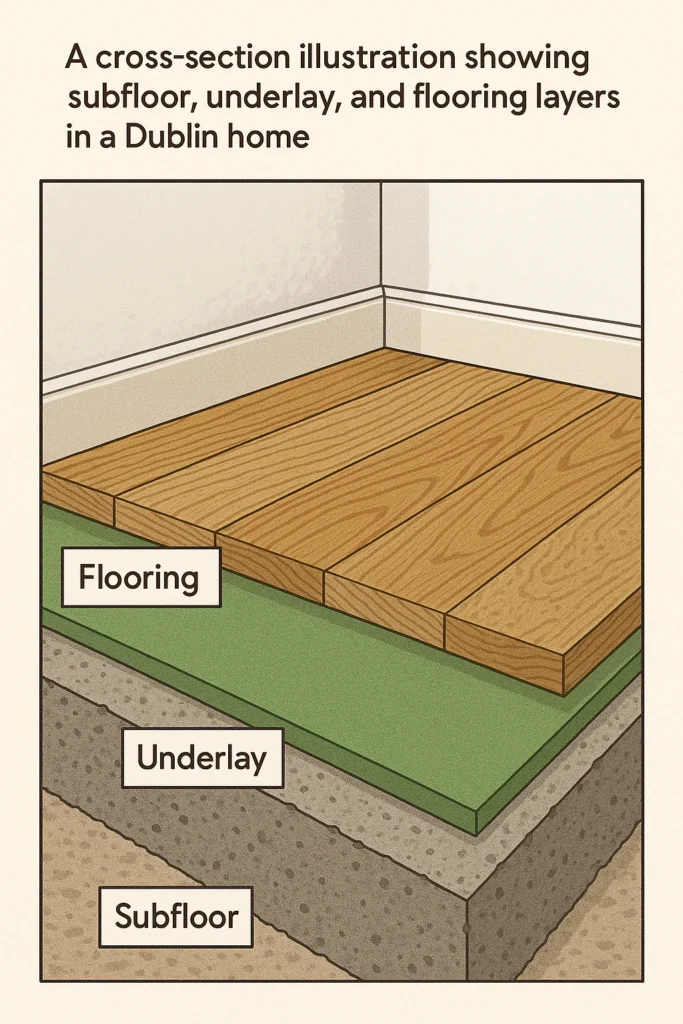
Section 3: Popular Flooring Options in Dublin
Dubliners today have more flooring choices than ever before, ranging from timeless hardwood to practical laminates and stylish vinyl. The right floor not only depends on taste but also on budget, lifestyle, and the unique challenges of the Irish climate. Below is a breakdown of the most popular flooring options in Dublin, along with insights into where they work best and what to expect in terms of maintenance and costs.
Solid Hardwood Floors
Best for: Period homes, high-end renovations, and buyers seeking long-term value.
Solid hardwood remains one of the most prestigious choices for Dublin homes, particularly in Georgian and Victorian houses where traditional oak or walnut floors match the architectural character. Hardwood is prized for its durability, natural warmth, and ability to be sanded and refinished multiple times.
However, hardwood requires a stable indoor climate, something Dublin’s damp weather can challenge. Excess moisture may cause boards to swell, while overly dry winters can lead to gaps. Professional fitting, combined with proper acclimatisation before installation, is essential to avoid these issues.
Pros: Long lifespan, adds property value, timeless beauty.
Cons: Higher cost (€70–€120 per m² including fitting), sensitive to moisture.
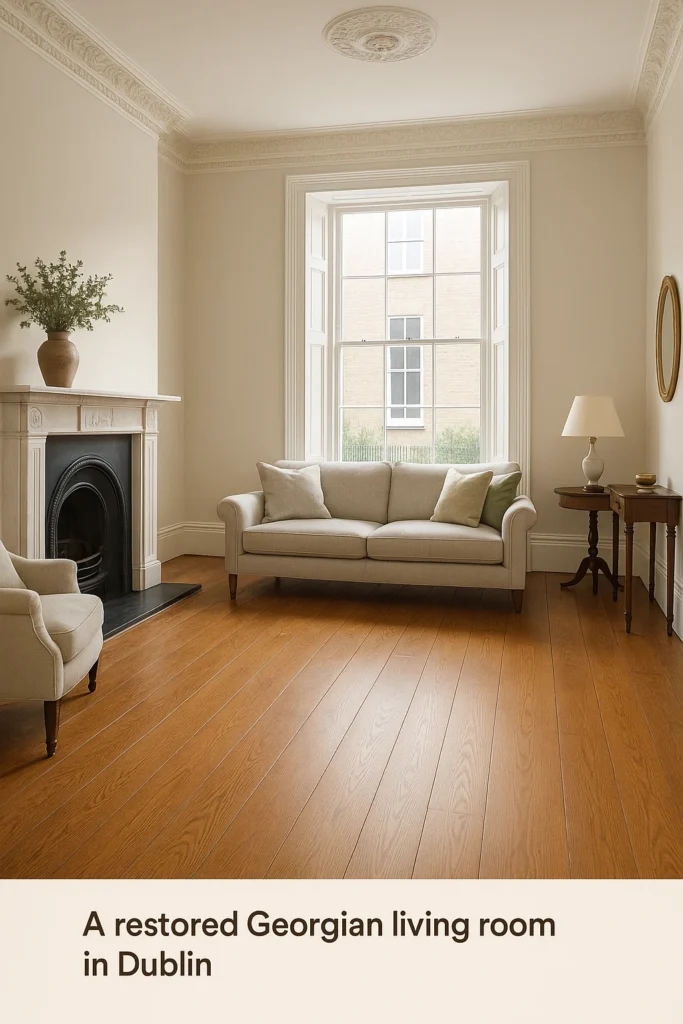
Engineered Wood Flooring
Best for: Modern apartments, busy family homes, and areas with underfloor heating.
Engineered wood has become Dublin’s most popular alternative to solid timber. Made of multiple layers topped with real wood veneer, it provides the look of hardwood while being more stable in changing climates. For apartments in Sandyford, Docklands, or Tallaght, engineered oak is often the go-to option.
Engineered wood is also compatible with underfloor heating, increasingly common in Dublin’s new builds. Many local suppliers stock premium European brands, offering finishes from rustic herringbone to sleek matt oak.
Pros: More moisture-resistant, wider design range, easier installation.
Cons: Can be refinished fewer times than solid wood.
Price range: €50–€90 per m² fitted.
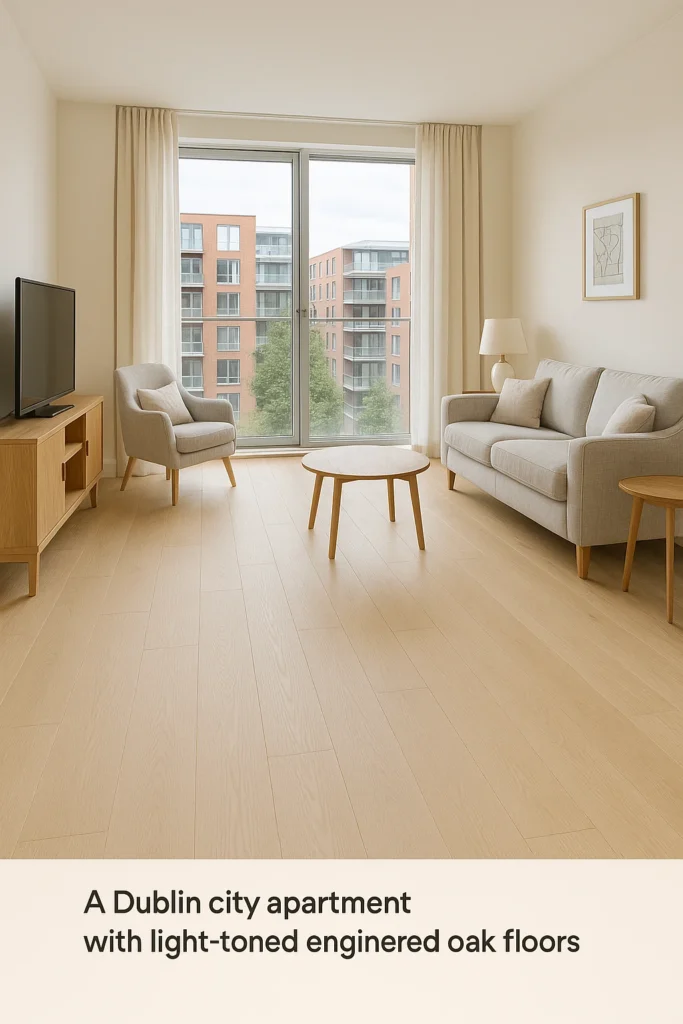
Laminate Flooring
Best for: Budget-friendly projects, rental properties, and quick renovations.
Laminate flooring is the go-to choice for many Dublin landlords and first-time buyers. With click-lock systems, it is quick to install and offers a wide variety of styles mimicking wood, stone, or tile. Modern laminates are far superior to those of the past, with water-resistant versions now widely available.
For homes in areas like Lucan or Finglas where families want durable but affordable solutions, laminate provides excellent value. However, unlike engineered wood, laminate cannot be refinished once damaged.
Pros: Low cost (€20–€40 per m² with fitting), easy installation, huge variety.
Cons: Cannot be refinished, less premium feel.
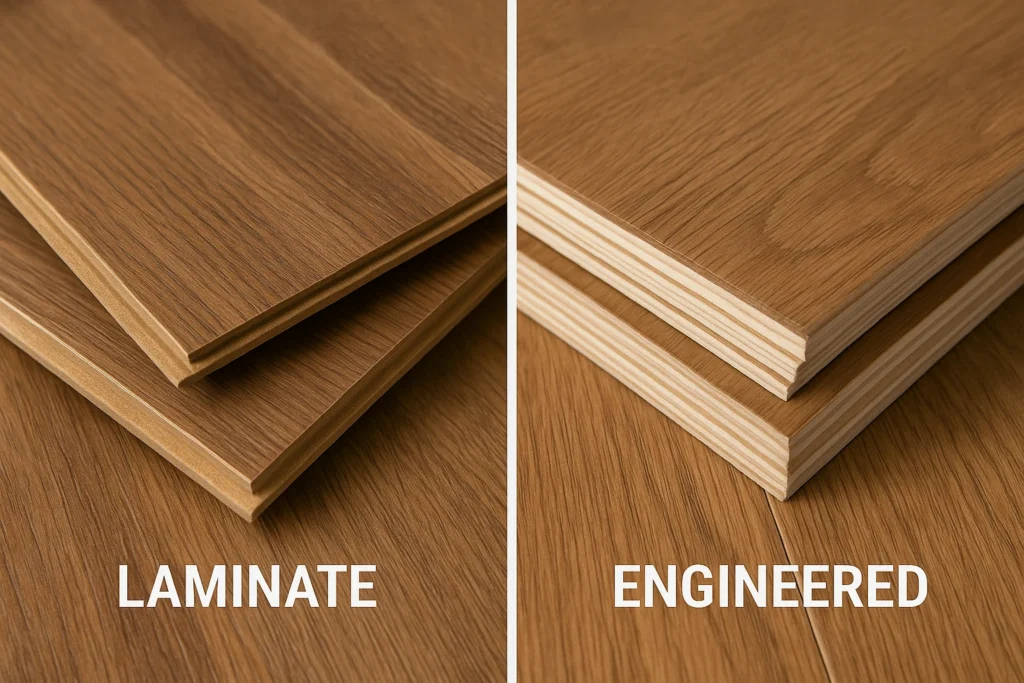
Vinyl & Luxury Vinyl Tile (LVT)
Best for: Kitchens, bathrooms, and high-traffic areas.
Vinyl flooring, especially LVT, has exploded in popularity across Dublin in recent years. Known for being waterproof, durable, and stylish, vinyl is ideal for households dealing with pets, children, or heavy footfall. In apartments across Dublin 8 or family houses in Clontarf, vinyl provides a practical yet attractive solution.
LVT options include wood and stone effects that are almost indistinguishable from the real thing. With improved textures and finishes, many homeowners now see vinyl as a design-forward choice rather than a budget compromise.
Pros: Waterproof, comfortable underfoot, affordable.
Cons: Lower resale value compared to wood.
Price range: €30–€60 per m² with fitting.
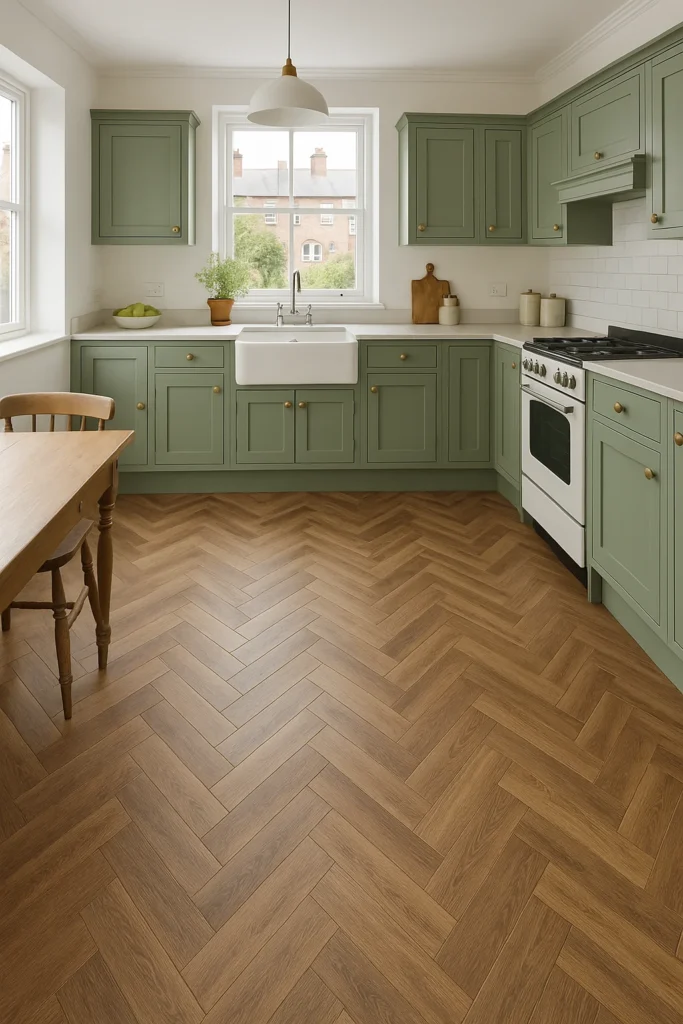
Carpets & Rugs
Best for: Bedrooms, living rooms, and noise reduction in city apartments.
Carpets remain a favourite for comfort and warmth, especially in Dublin’s colder months. In apartments around Dublin City Centre, carpets are valued for their soundproofing qualities, reducing noise between floors. For suburban homes, soft pile carpets in bedrooms add cosiness.
Rugs, on the other hand, provide flexibility, allowing homeowners to add style without committing to full carpet coverage. Dublin’s design stores in areas like Rathmines or Dundrum often stock unique rug collections imported from Europe and the Middle East.
Pros: Warm, comfortable, excellent for noise reduction.
Cons: Stains easily, requires regular cleaning.
Price range: €25–€50 per m² for carpet fitting.
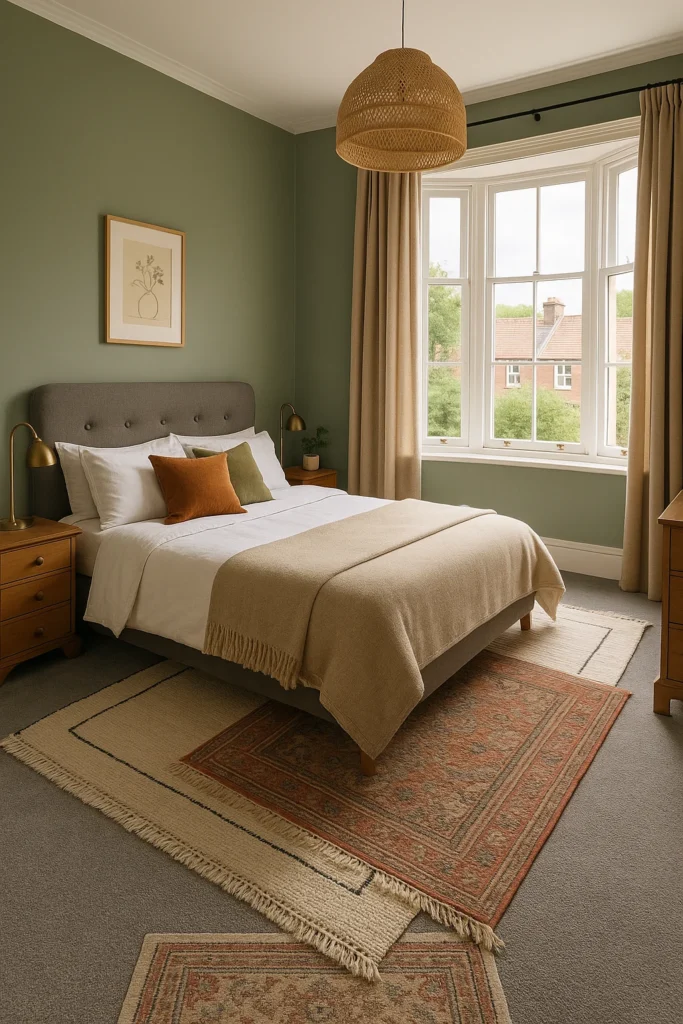
Where Dubliners Buy Their Floors
Several local suppliers dominate the Dublin flooring market:
- FBS Flooring– Best for finding models that fit your needs
- Furniture Factory Dublin – Known for engineered and laminate floors.
- Polyfloor – Offers carpets, vinyl, and wood flooring.
- Wood Innovation Ireland – Specialists in bespoke engineered wood.
Working with local suppliers not only ensures access to quality materials but also provides after-sales support and installation services tailored to Dublin’s housing conditions.
Section 4: Floor Fitting Costs in Dublin (2025-26 Guide)
For Dublin homeowners, one of the most common questions before starting a flooring project is simple: “How much will it cost?” The answer depends on the type of flooring chosen, the size of the space, and the level of preparation required. Dublin is one of Ireland’s most expensive cities for trades and construction services, but with good planning, it is possible to balance quality with affordability.
Average Costs by Flooring Type
Floor fitting prices in Dublin vary significantly depending on the material:
- Solid hardwood – €70 to €120 per m² (including labour). Premium oak and walnut typically fall at the higher end.
- Engineered wood – €50 to €90 per m². A balance between durability and affordability.
- Laminate flooring – €20 to €40 per m². Popular for rental properties and quick upgrades.
- Vinyl / LVT – €30 to €60 per m². Costs rise for luxury finishes like herringbone.
- Carpet fitting – €25 to €50 per m², depending on pile quality and underlay.
These figures include supply and fit but may rise for premium brands or complex layouts (e.g., herringbone patterns).
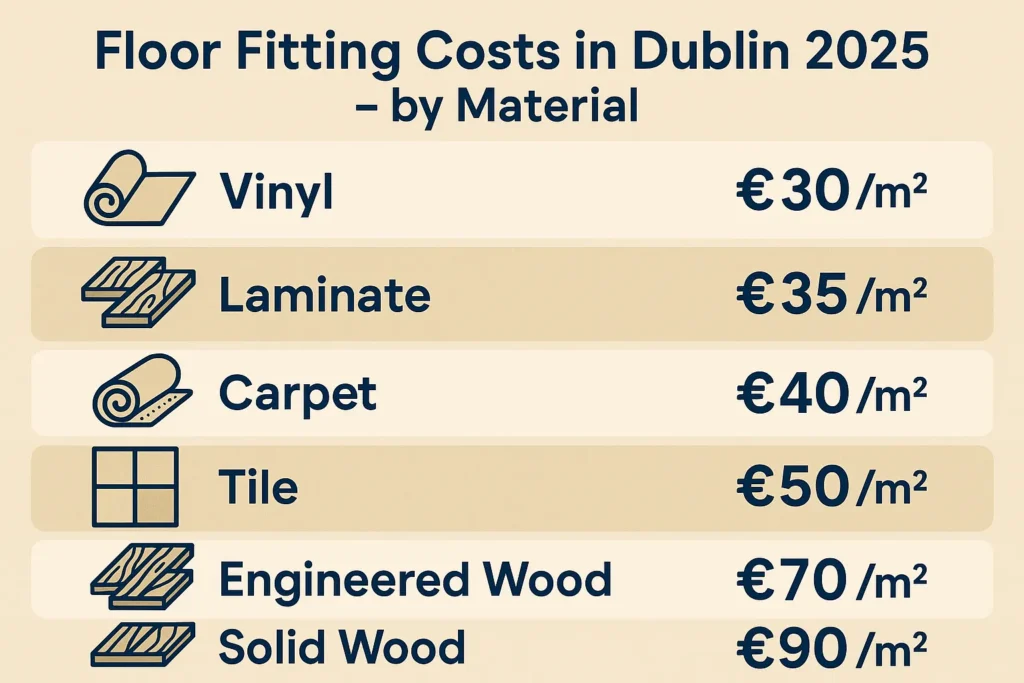
Labour Costs vs Materials
In Dublin, labour can represent 40–60% of the overall budget. Professional fitters generally charge:
- €20–€35 per m² for straightforward laminate or vinyl installations.
- €30–€50 per m² for engineered or solid wood floors requiring more skill.
- €5–€10 per m² for carpet installation (excluding carpet supply).
Complex jobs such as staircases, patterned layouts, or moisture treatments push costs higher.
Material prices also fluctuate depending on source. For example, local suppliers like Right Price Tiles often run discounts, while bespoke engineered wood from Wood Flooring Ireland comes at a premium.
Extra Expenses to Consider
Homeowners often underestimate additional costs that can quickly add up:
- Subfloor preparation – levelling compound, damp-proof membranes, or repairing joists (€5–€20 per m²).
- Old floor removal & disposal – €200–€500 for a standard three-bed semi-detached.
- Furniture moving – Some fitters charge €50–€150 for heavy lifting.
- Skirting boards & trims – €5–€10 per metre.
- Underlay – €3–€8 per m², depending on acoustic or thermal properties.
For apartments in central Dublin, access restrictions (e.g., parking permits, lift use) may also add to labour time and overall cost.
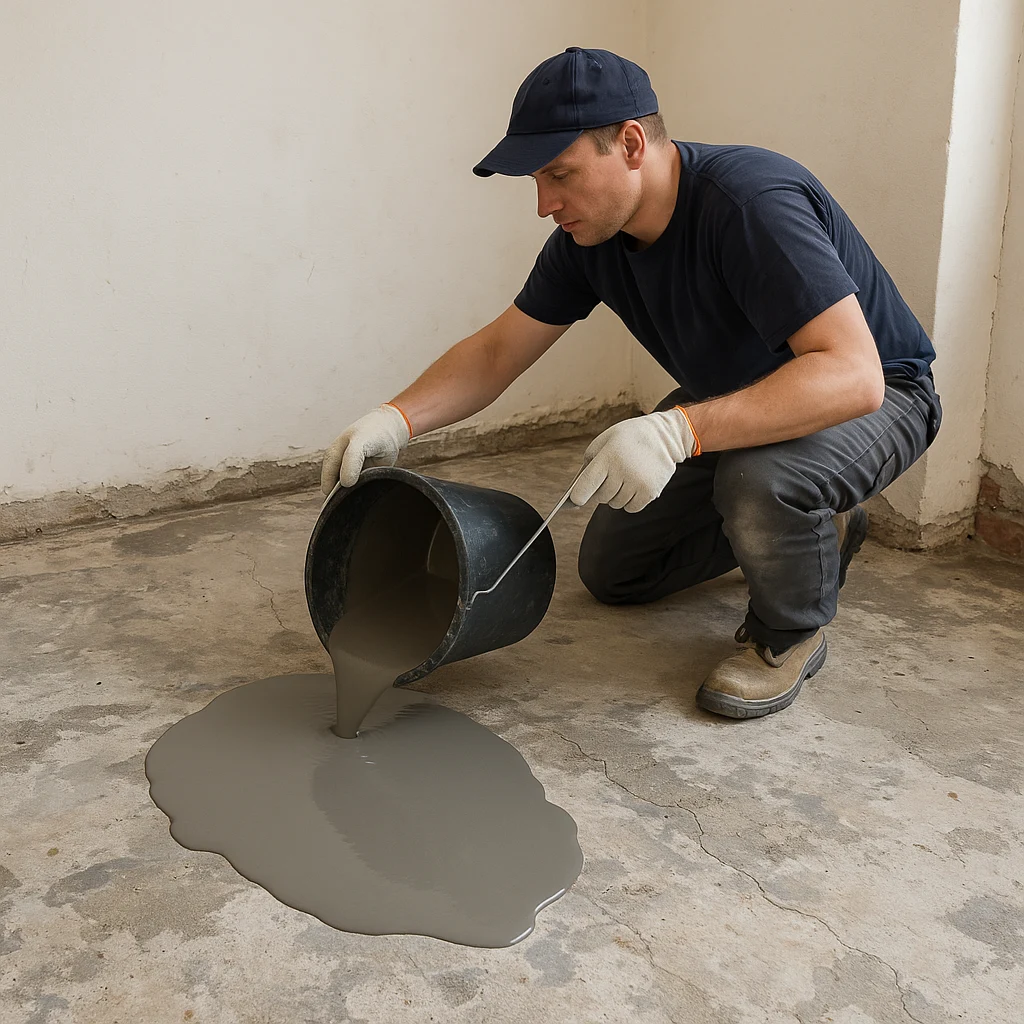
Cost-Saving Tips Without Cutting Corners
- Compare multiple quotes – Dublin has dozens of flooring specialists; prices vary widely.
- Bundle supply and fit – Many suppliers offer discounts if you purchase materials and fitting together.
- Choose durable mid-range options – Engineered wood often offers the best balance of cost and longevity.
- Plan ahead – Booking in advance may secure lower labour rates during quieter seasons (autumn/winter).
- DIY only where safe – Tasks like removing old carpet can be done by homeowners to save on labour.
Costs in Dublin vs the Rest of Ireland
Compared with other Irish cities such as Cork or Galway, Dublin fitting costs are typically 10–20% higher due to labour demand and property types. However, competition among fitters in the capital also means deals are often available, especially for larger projects or repeat customers.
Section 5: Choosing the Right Floor Fitter in Dublin
The success of a flooring project depends as much on the quality of the fitter as it does on the material chosen. Even the finest oak or luxury vinyl can look cheap and wear quickly if poorly installed. In Dublin, where housing types vary and building standards differ between old and new developments, choosing the right floor fitter is essential for achieving a flawless finish that lasts.
Qualities of a Professional Floor Fitter
Not all tradespeople are equal, and flooring requires precision. A reliable Dublin floor fitter should demonstrate:
- Experience and training – Look for professionals with at least several years of flooring-specific experience. Many are certified through trade bodies such as the National Wood Flooring Association (NWFA) or hold local training credentials.
- Portfolio of work – Genuine fitters can show before-and-after photos of previous Dublin projects, from period homes in Ranelagh to apartments in Dublin 4.
- Attention to detail – Precision cutting, proper expansion gaps, and seamless trims are marks of a skilled fitter.
- Insurance and guarantees – Always confirm that public liability insurance and workmanship warranties are provided.
If you are unsure who to contact, please drop a call at FBS Flooring, and we will give you the best options.
Why Local Expertise Matters in Dublin
Flooring challenges differ across Dublin’s diverse housing stock:
- Older Georgian & Victorian homes often have uneven timber joists or moisture issues that require specialised subfloor preparation.
- New-build apartments in Docklands or Sandyford typically come with concrete bases that need levelling compounds and acoustic underlay to reduce noise transfer.
- Family homes in the suburbs such as Clontarf or Lucan often prioritise durable, low-maintenance flooring to withstand daily wear.
A fitter familiar with Dublin’s unique property mix will anticipate these challenges and recommend tailored solutions.
Questions to Ask Before Hiring
When interviewing potential fitters, Dublin homeowners should always ask:
- How many years have you been fitting floors in Dublin?
- Can you provide references or customer reviews?
- Do you supply materials as well as fittings?
- What guarantees do you offer on workmanship?
- How do you handle subfloor preparation and unexpected issues?
The answers will quickly reveal whether a fitter is thorough and trustworthy.
Where to Find Reputable Floor Fitters in Dublin
Several reliable channels exist for finding floor fitters in the city. We at FBS ensure to find you the best options:
- Local suppliers – Stores like Des Kelly Interiors or Right Price Tiles often recommend fitters they work with regularly.
- Online directories – Websites such as Checkatrade.ie and Onlinetradesmen.ie list vetted Dublin flooring professionals with customer reviews.
- Google Maps & reviews – Searching “floor fitter Dublin” brings up dozens of businesses, including us, with ratings offering insight into reliability.
- Word of mouth – Dublin’s close-knit communities, from Rathmines to Drumcondra, often share trusted local tradespeople.
Red Flags to Avoid
Unfortunately, not all fitters deliver on promises. Beware of:
- Quotes that are far below market average — often leading to rushed jobs or hidden costs.
- Lack of written contracts or guarantees.
- Refusal to provide references or portfolios.
- Fitters who pressure homeowners into buying specific materials without offering alternatives.
Choosing a cheap but unqualified fitter may save money initially but often results in costly repairs later.
Final Thoughts
Hiring the right floor fitter in Dublin is about more than price; it’s about trust, skill, and local knowledge. A professional with proven experience, proper insurance, and familiarity with Dublin’s housing challenges can transform a flooring project into a long-term investment. By asking the right questions and checking credentials, Dublin homeowners can ensure their new floors not only look stunning but also stand the test of time.
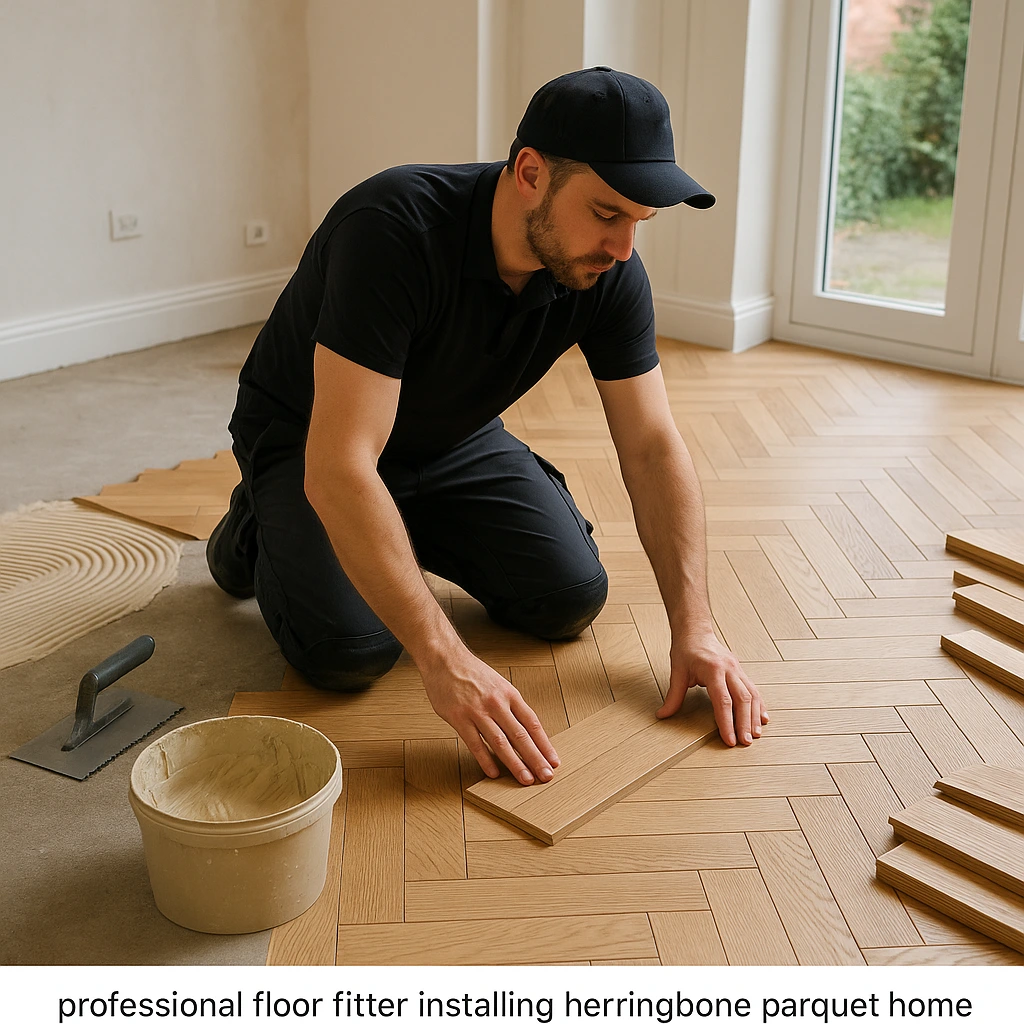
Section 6: Step-by-Step Floor Fitting Process
For many Dublin homeowners, the floor fitting process can seem like a mystery. Knowing what to expect not only builds confidence when hiring a professional but also helps you prepare your home and budget. While the exact steps vary depending on the flooring type, most professional installations follow a structured process. Below is a step-by-step breakdown of how floor fitters in Dublin typically operate.
1. Pre-Fitting Inspection
Before any tools come out, a thorough inspection is essential. A professional fitter will:
- Check moisture levels in both the subfloor and the air — crucial in Dublin’s damp climate.
- Assess the condition of the subfloor, looking for cracks, unevenness, or damaged joists.
- Take precise measurements, ensuring accurate material estimates and cutting.
This stage prevents future problems such as warping, lifting, or gaps. For example, a Georgian home in Rathmines may require significant subfloor repair, while a modern Docklands apartment might need acoustic underlay to reduce sound transfer.

2. Preparation and Subfloor Work
Preparation is often the most time-consuming part of the project. Depending on the property, it may involve:
- Removing old flooring – carpet, tiles, or timber planks.
- Levelling the surface – using self-leveling compound for concrete or planing timber joists.
- Applying damp-proof membranes – particularly important in basements or ground-floor rooms.
- Cleaning thoroughly – dust, debris, or grease can compromise adhesives and finishes.
Skipping these steps can ruin even the most expensive floor. In Dublin’s climate, moisture-proofing is especially important to ensure durability.
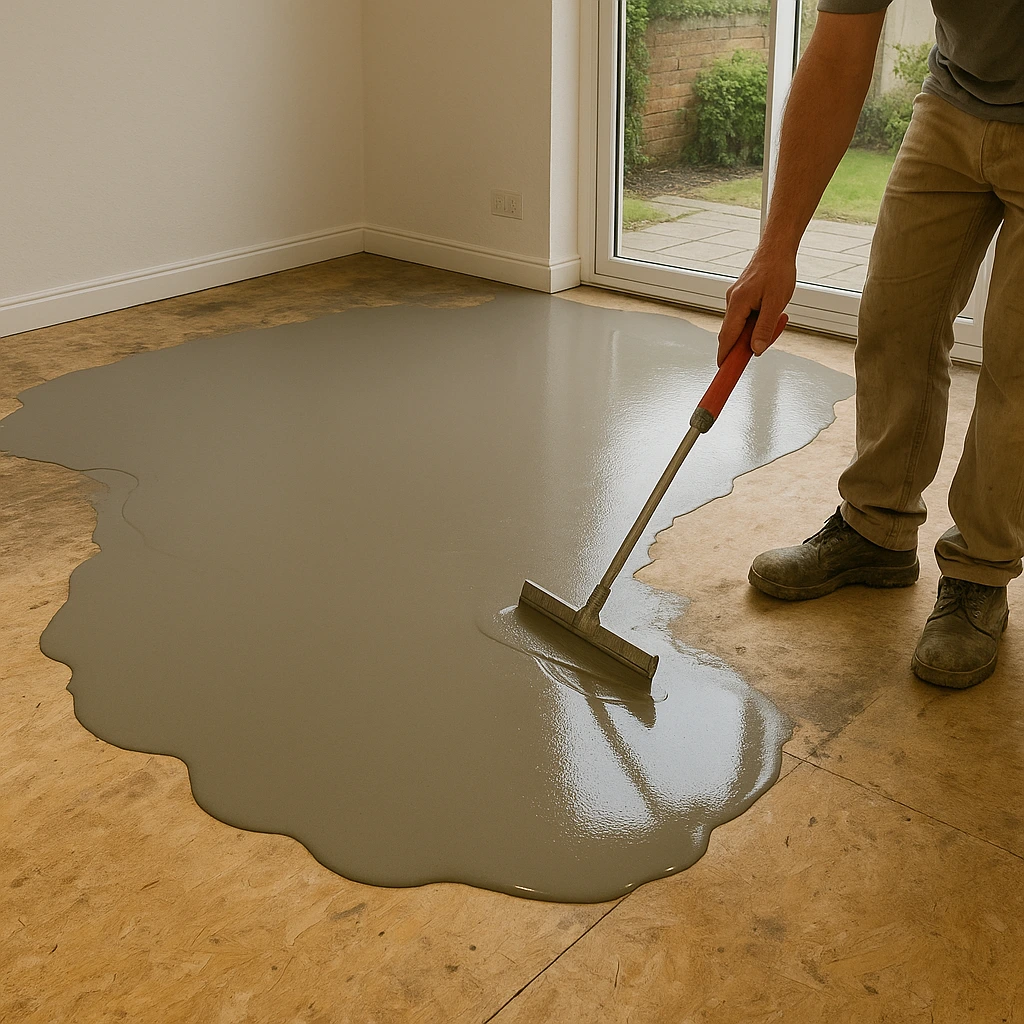
3. Installing the Underlay
Underlay provides insulation, soundproofing, and a smooth base for flooring. Fitters typically use:
- Foam underlay for laminate and engineered floors.
- Rubber or cork underlay for noise reduction in apartments.
- Felt or fibre underlay for carpets.
The right underlay makes a huge difference, especially in multi-storey Dublin buildings where soundproofing between floors is legally required in some developments.
4. Fitting the Flooring
This is where the transformation takes shape. Methods differ depending on the flooring type:
- Floating installation – Boards click together without being fixed to the subfloor. Common for laminate and engineered wood.
- Glue-down method – Adhesive secures planks or tiles directly to the surface, often used for vinyl or parquet.
- Nail-down method – Solid wood planks are nailed to joists, a traditional approach for older Dublin houses.
- Stretch fitting – Carpets are pulled tight and secured with grippers around the room’s edge.
Professional fitters in Dublin often mix techniques depending on the property’s structure. For example, engineered wood in a Ballsbridge apartment may be glued down for stability, while a suburban Lucan home may benefit from floating laminate for speed and affordability.
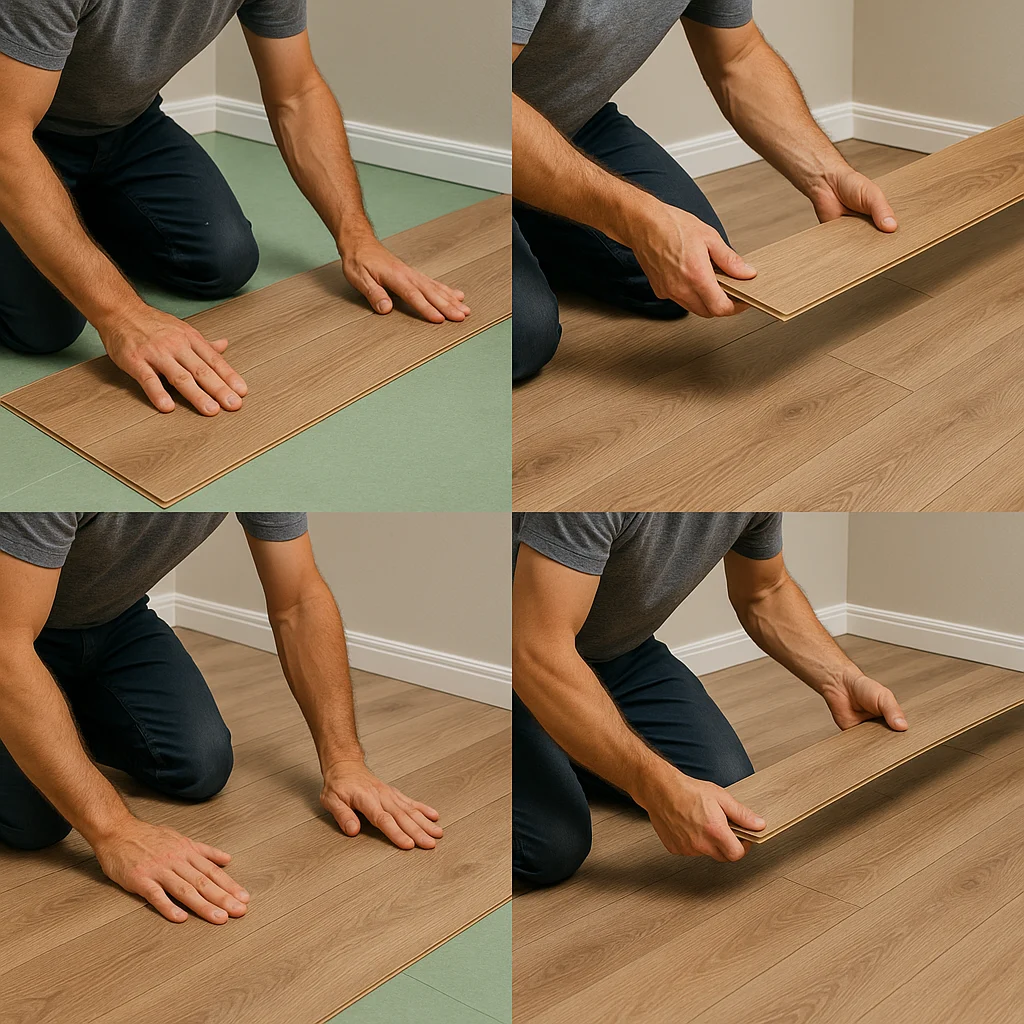
5. Finishing Touches
The details make the difference between a floor that looks average and one that looks exceptional. Fitters finish by:
- Installing skirting boards or beading to cover expansion gaps.
- Adding thresholds or trims at doorways for a seamless transition.
- Sanding and sealing solid wood floors for protection.
- Cleaning and vacuuming to present a spotless finish.
These steps elevate the project from a simple installation to a professional job that enhances the entire room.
6. Post-Installation Care & Handover
Once the floor is complete, a good fitter will provide aftercare instructions. This may include:
- How long before walking on the floor (especially after glue-down or sealing).
- Recommended cleaning methods for the material fitted.
- Warranty details covering both materials and labour.
Homeowners should always follow these guidelines to preserve their investment. For example, engineered wood floors may need 24–48 hours to settle, while carpets often require a professional clean once fitted to remove loose fibres.
Why This Process Matters
Cutting corners on any of these stages can lead to costly issues, warped boards, uneven surfaces, or moisture damage. Dublin fitters who follow a professional process ensure not only visual appeal but also long-term durability, making the investment worthwhile.
Section 7: Common Floor Fitting Problems in Dublin & How to Avoid Them
Even with the best materials, a flooring project can go wrong if certain challenges are ignored. Dublin’s unique mix of climate, housing stock, and renovation practices means some problems appear more often here than elsewhere in Ireland. Understanding these pitfalls — and knowing how to prevent them — helps homeowners protect their investment.
Moisture and Damp Issues
Dublin’s maritime climate brings consistent rainfall and high humidity. In older homes, especially basements or ground floors, this can lead to subfloor dampness. When not addressed, moisture causes warping, swelling, or mould growth under flooring.
Prevention:
- Always use a moisture barrier or damp-proof membrane on ground-level concrete.
- Allow wooden boards to acclimatise indoors for at least 48 hours before fitting.
- Work with fitters who use moisture meters to check conditions before installation.
Creaking and Squeaking Floors
Many of Dublin’s Georgian and Victorian houses have timber joists that have shifted over time. When new floors are installed on top of unstable bases, creaks and squeaks become inevitable.
Prevention:
- Repair or reinforce loose joists before laying new flooring.
- Use proper adhesives and fixings for solid wood.
- Ensure the correct underlay is installed for floating floors.
Uneven Subfloors
Old houses and even some new-build apartments in Dublin suffer from uneven subfloors. Left uncorrected, they can cause gaps between planks, poor alignment, or premature wear.
Prevention:
- Apply self-leveling compound on concrete bases.
- Plane down or replace uneven timber sections.
- Hire fitters who include subfloor prep as part of their service.
DIY Mistakes
In an effort to save costs, some homeowners attempt DIY installation. While laminate click systems seem straightforward, mistakes such as skipping underlay, failing to leave expansion gaps, or cutting boards inaccurately can lead to expensive repairs later.
Prevention:
- Attempt DIY only for small, straightforward rooms.
- Leave complex projects — herringbone parquet, staircases, or large spaces — to professionals.
- Always follow manufacturer guidelines carefully.
Poor Material Choices
Choosing the wrong material for the wrong environment is another common issue. For example, fitting solid hardwood in a damp kitchen in Dublin almost guarantees swelling and warping.
Prevention:
- Select materials suited to the room: vinyl or LVT for kitchens, engineered wood for living rooms, carpet for bedrooms.
- Consult fitters who can advise on the best options for Dublin’s climate.
Final Thoughts
Most floor fitting problems in Dublin stem from two things: poor preparation and lack of professional input. By addressing moisture, levelling, and stability before laying new floors, and by avoiding rushed DIY jobs, homeowners can enjoy durable, beautiful flooring. Hiring an experienced Dublin floor fitter remains the most effective way to prevent costly mistakes.
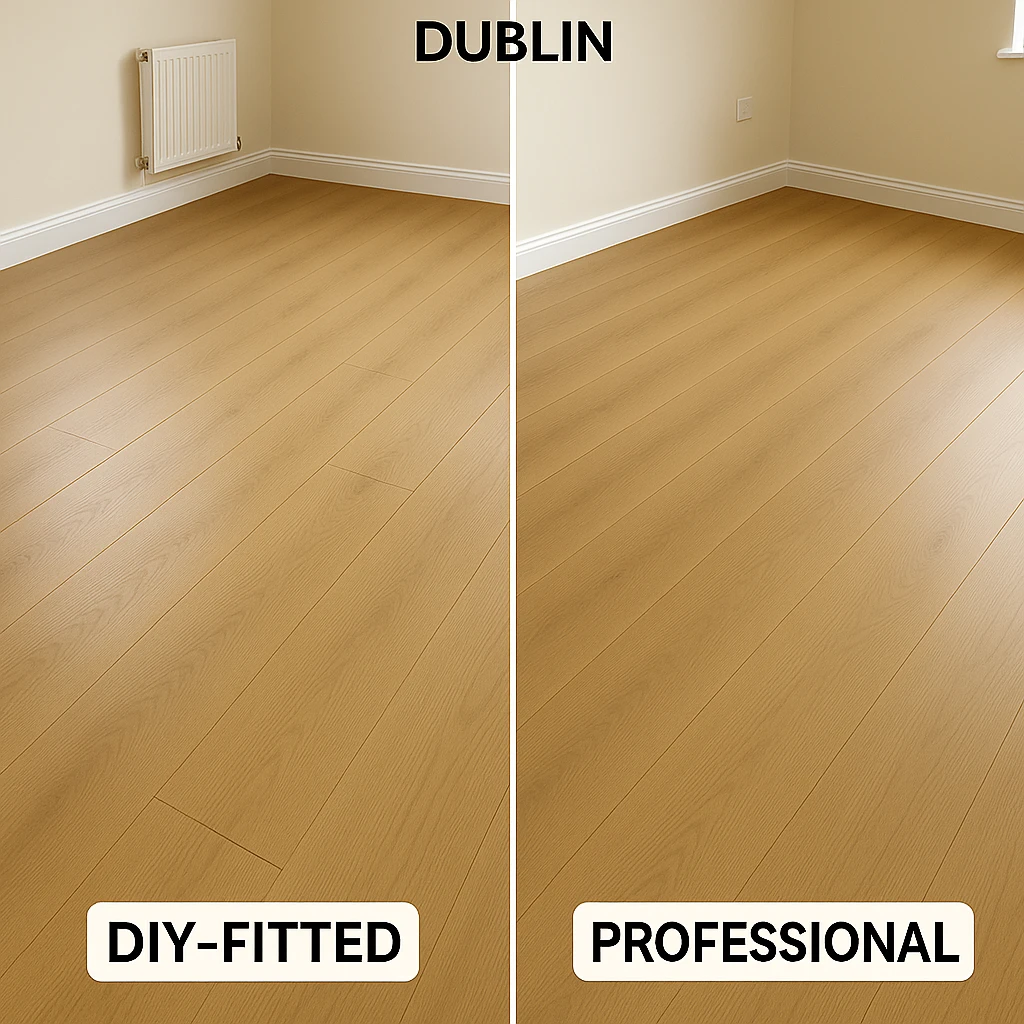
Section 8: Maintenance & Long-Term Care of Floors
Investing in a professionally fitted floor is only the first step. To ensure durability and beauty, Dublin homeowners need to follow proper maintenance practices. The city’s climate, with frequent rain and humidity, makes care especially important.
Cleaning Tips by Flooring Type
- Solid and engineered wood: Sweep regularly with a soft brush and use a damp (not wet) mop with wood-safe cleaner. Avoid harsh chemicals that strip protective coatings.
- Laminate flooring: Vacuum with a hard-floor setting and clean with slightly damp microfiber mops. Excess water can seep into joints, causing swelling.
- Vinyl & LVT: Wipe spills immediately and clean with mild detergents. Vinyl is waterproof but benefits from regular care to maintain shine.
- Carpets: Vacuum at least twice a week and arrange professional deep cleans once or twice a year. Stains should be treated quickly with carpet-specific solutions.
Dublin Climate Considerations
Moisture is the biggest threat. Even well-fitted wood floors can expand in humid summers and contract in dry winters. Using a dehumidifier in basements or poorly ventilated rooms prevents warping. In apartments, noise-proof underlays should be maintained to comply with sound regulations.
Recommended Products
Local suppliers stock cleaners tailored to specific flooring types. Many Dubliners trust eco-friendly Irish-made products to reduce chemical exposure, especially in homes with children and pets.
Final Note: A few minutes of regular care will extend a floor’s lifespan by decades, protecting the investment made during fitting.
Section 9: Local Insights: Floor Fitting in Dublin
Flooring trends in Dublin evolve with changing lifestyles, architecture, and design preferences. Beyond functionality, many homeowners seek style and sustainability.
Design Trends
- Herringbone parquet has resurged, particularly in renovated Georgian and Edwardian homes.
- Light oak engineered flooring dominates in modern apartments, creating brighter, airier interiors.
- Eco-conscious choices such as bamboo and cork are gaining traction, reflecting Dubliners’ growing environmental awareness.
Practical Demands
Families in suburban areas prefer durable laminates and vinyl, especially in kitchens and living rooms where daily activity is heavy. Meanwhile, renters and landlords often prioritise cost-effective options like laminate for easy replacement between tenants.
Case Studies Across Dublin
- A terraced house in Phibsborough opted for engineered oak to balance tradition with durability.
- A Dublin 8 apartment fitted with luxury vinyl in a herringbone pattern, achieving the look of hardwood at half the cost.
- In Clontarf, a family chose stain-resistant carpets for bedrooms, pairing them with engineered wood downstairs for a warm yet practical mix.
These examples highlight the adaptability of flooring solutions to the city’s diverse property landscape.
Section 10: Floor Fitting Dublin – FAQ
To answer the most common queries, here are ten FAQs homeowners ask when considering new flooring in Dublin.
- How much does it cost to fit wooden floors in Dublin?
On average, €50–€90 per m² for engineered wood, and €70–€120 per m² for solid wood. - Can I fit new floors over old tiles?
Yes, provided the surface is clean, level, and dry. Many vinyl and laminate systems allow direct installation. - How long does professional floor fitting take?
A standard three-bedroom Dublin semi-detached usually takes 2–4 days, depending on preparation. - Do I need an underlay for laminate or vinyl flooring?
Yes. Underlay provides insulation, noise reduction, and moisture protection. - What’s the most durable flooring for Dublin rentals?
Vinyl and laminate are the most popular for rentals due to low maintenance and cost-effectiveness. - Can underfloor heating be combined with wood floors?
Yes, but engineered wood is safer than solid wood, as it withstands temperature changes better. - How to deal with noisy or creaking floors?
The cause is usually loose subfloors. Reinforcement or professional adjustments are required. - What’s the difference between supply & fit packages?
Supply & fit includes both materials and installation. This often saves money compared to sourcing separately. - Do Dublin floor fitters offer warranties?
Most reputable companies offer a workmanship guarantee (typically 1–5 years) plus manufacturer warranties on materials. - How to choose between engineered wood and laminate?
Engineered wood offers authenticity and resale value, while laminate is cheaper and more resistant to scratches.
Section 11: Conclusion & Call to Action
Floor fitting in Dublin is more than a renovation; it is an investment in comfort, design, and property value. The city’s mix of historic and modern buildings means no two projects are the same, and the right choice depends on balancing budget, lifestyle, and aesthetics.
By understanding the process, the costs, and the common pitfalls, Dublin homeowners can make informed decisions. Professional fitting ensures durability and protects against the challenges of Ireland’s damp climate. Whether you’re restoring a period home or upgrading an apartment, the right floor transforms not only the look of a property but also how it feels to live in.
Take the next step today. Contact FBS Flooring floor fitter, compare quotes, and bring your flooring vision to life. With expert guidance, your investment will reward you for decades to come.
